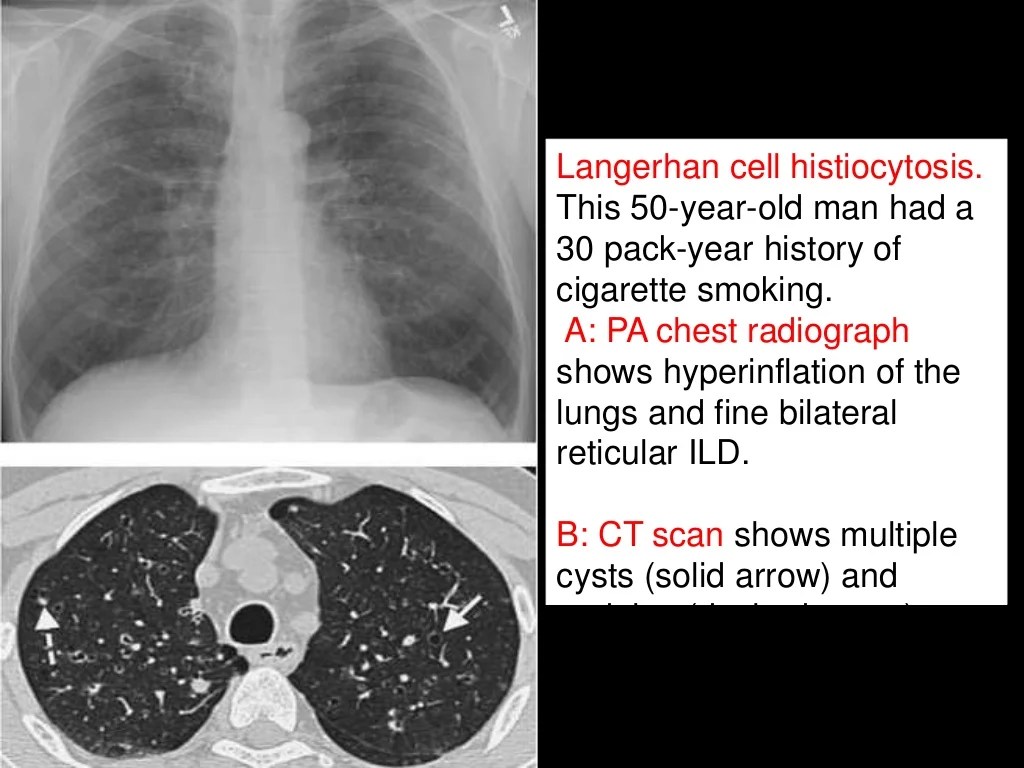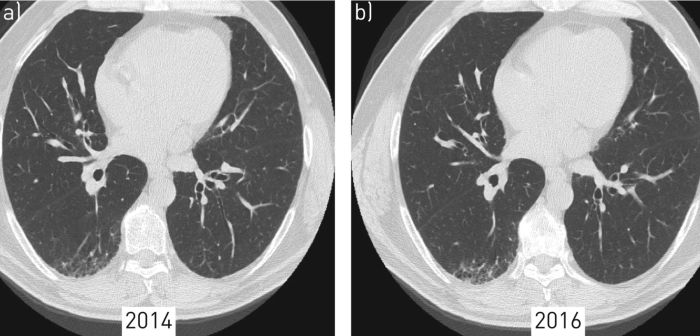Parenchymal lung disease, a complex labyrinth of respiratory ailments, unfolds its enigmatic nature within the delicate confines of the lungs. This intricate network of conditions unveils a tapestry of causes, symptoms, and treatments, beckoning us to delve into its intricate web.
From the subtle whispers of interstitial fibrosis to the thunderous roar of pneumonia, parenchymal lung diseases paint a diverse canvas of respiratory challenges. Their origins lie in a myriad of factors, ranging from environmental toxins to genetic predispositions, while their symptoms manifest in a symphony of coughs, shortness of breath, and fatigue.
Definition and Overview

Parenchymal lung disease refers to a group of conditions that primarily affect the parenchyma, the functional tissue of the lungs. These diseases involve inflammation, scarring, or other abnormalities within the lung tissue itself, as opposed to the airways or blood vessels.
Parenchymal lung diseases can be classified into two main types: restrictive and obstructive. Restrictive lung diseases reduce the lungs’ ability to expand, making it difficult to inhale. Obstructive lung diseases narrow the airways, making it difficult to exhale.
Types of Parenchymal Lung Diseases
- Interstitial lung diseases (ILDs): A group of over 200 conditions that cause inflammation and scarring of the lung tissue, leading to reduced lung function and shortness of breath. Examples include idiopathic pulmonary fibrosis (IPF), sarcoidosis, and hypersensitivity pneumonitis.
- Emphysema: A chronic obstructive pulmonary disease (COPD) that damages the alveoli, the tiny air sacs in the lungs. This damage leads to shortness of breath, wheezing, and coughing.
- Chronic bronchitis: Another COPD that causes inflammation and narrowing of the airways, leading to chronic coughing and mucus production.
- Pneumonia: An infection of the lung tissue that can cause inflammation, fluid buildup, and difficulty breathing.
- Lung cancer: A malignant tumor that starts in the lung tissue and can cause a variety of symptoms, including shortness of breath, coughing, and chest pain.
Causes and Risk Factors

Parenchymal lung diseases, which affect the functional tissue of the lungs, can arise from various causes. Understanding these causes and the associated risk factors is crucial for effective prevention and management of these conditions.
There are numerous factors that can contribute to the development of parenchymal lung diseases. These include:
Infections
- Bacterial infections, such as pneumonia and tuberculosis
- Viral infections, such as influenza and respiratory syncytial virus (RSV)
- Fungal infections, such as histoplasmosis and coccidioidomycosis
Environmental Factors
- Exposure to air pollution, including particulate matter, ozone, and nitrogen dioxide
- Exposure to occupational hazards, such as asbestos, silica, and coal dust
- Smoking, which is a major risk factor for chronic obstructive pulmonary disease (COPD)
Genetic Factors
- Certain genetic mutations can increase the risk of developing certain parenchymal lung diseases, such as cystic fibrosis and alpha-1 antitrypsin deficiency
Autoimmune Disorders
- Conditions like sarcoidosis and idiopathic pulmonary fibrosis can cause inflammation and scarring of the lung tissue
Other Risk Factors
- Advanced age
- Weakened immune system
- History of lung disease
Symptoms and Diagnosis
Parenchymal lung diseases present with a wide range of symptoms depending on the severity and type of the disease. Common symptoms include:
- Shortness of breath, especially with exertion
- Wheezing
- Cough, which may be dry or produce mucus
- Chest pain or discomfort
- Fatigue
- Weight loss
Diagnostic Tests
Diagnosing parenchymal lung diseases involves a combination of physical examination, medical history, and diagnostic tests. These tests may include:
- Chest X-ray:Provides an image of the lungs to detect abnormalities in lung tissue.
- Computed tomography (CT) scan:A more detailed imaging test that provides cross-sectional views of the lungs to assess the extent and severity of lung damage.
- Pulmonary function tests:Measure lung function by assessing the amount of air that can be inhaled and exhaled, as well as the rate at which oxygen is taken up by the lungs.
- Biopsy:Involves removing a small sample of lung tissue for examination under a microscope to confirm the diagnosis.
These tests help healthcare professionals determine the type of parenchymal lung disease, its severity, and the appropriate course of treatment.
Treatment and Management
Treatment for parenchymal lung diseases depends on the underlying cause and severity of the condition. The primary goal of treatment is to manage symptoms, prevent complications, and improve overall lung function.
There are various treatment options available, including:
- Medications:Bronchodilators, inhaled steroids, and antibiotics are commonly used to relieve symptoms and reduce inflammation.
- Oxygen Therapy:Supplemental oxygen can help improve breathing and oxygen levels in the blood.
- Pulmonary Rehabilitation:This program involves exercises and education to help patients improve their breathing and overall health.
- Surgery:In some cases, surgery may be necessary to remove damaged lung tissue or repair structural abnormalities.
Management Strategies, Parenchymal lung disease
In addition to specific treatments, there are several management strategies that can help improve symptoms and prevent complications:
- Smoking Cessation:Quitting smoking is crucial for preventing further damage to the lungs.
- Infection Prevention:Regular vaccinations and proper hygiene can help reduce the risk of respiratory infections.
- Air Quality Management:Avoiding exposure to air pollution and other irritants can help protect the lungs.
- Regular Check-ups:Monitoring lung function and symptoms through regular check-ups allows for early detection and prompt treatment of any changes.
Prognosis and Prevention: Parenchymal Lung Disease
The prognosis of parenchymal lung diseases varies depending on the type and severity of the condition. Some diseases, such as sarcoidosis, may resolve on their own, while others, such as idiopathic pulmonary fibrosis, can be progressive and lead to respiratory failure.
The prognosis is generally better if the disease is diagnosed and treated early.
There are a number of things that can be done to prevent parenchymal lung diseases, including:
Smoking Cessation
- Smoking is one of the leading causes of parenchymal lung diseases, including COPD and lung cancer. Quitting smoking is the single most important thing you can do to prevent these diseases.
Avoidance of Air Pollution
- Air pollution can also contribute to the development of parenchymal lung diseases. If you live in an area with high levels of air pollution, it is important to take steps to reduce your exposure, such as wearing a mask when outdoors or using an air purifier in your home.
Occupational Exposure
- Some occupations, such as mining and construction, can expose workers to harmful dusts and chemicals that can lead to parenchymal lung diseases. It is important to take steps to protect yourself from these exposures, such as wearing a respirator and following safety protocols.
Vaccinations
- There are a number of vaccines available that can help to prevent parenchymal lung diseases, such as the flu vaccine and the pneumonia vaccine. It is important to stay up-to-date on your vaccinations to help protect yourself from these diseases.
Final Thoughts

Parenchymal lung diseases, with their enigmatic complexity, challenge our understanding of respiratory health. As we unravel the intricate tapestry of their causes, symptoms, and treatments, we gain invaluable insights into the delicate balance of our pulmonary system. By embracing a comprehensive approach that encompasses prevention, early diagnosis, and tailored therapies, we can navigate the labyrinth of parenchymal lung diseases, empowering individuals to breathe with renewed vigor.
FAQ Insights
What are the common types of parenchymal lung diseases?
Interstitial fibrosis, pneumonia, and sarcoidosis are some of the prevalent forms of parenchymal lung diseases.
What are the primary symptoms associated with parenchymal lung diseases?
Persistent cough, shortness of breath, fatigue, and wheezing are common symptoms experienced by individuals with parenchymal lung diseases.
How are parenchymal lung diseases diagnosed?
Diagnosis typically involves a combination of physical examination, medical history review, imaging tests (such as X-rays or CT scans), and lung function tests.
What treatment options are available for parenchymal lung diseases?
Treatment strategies vary depending on the specific type of parenchymal lung disease and may include medications, oxygen therapy, pulmonary rehabilitation, and in severe cases, lung transplantation.